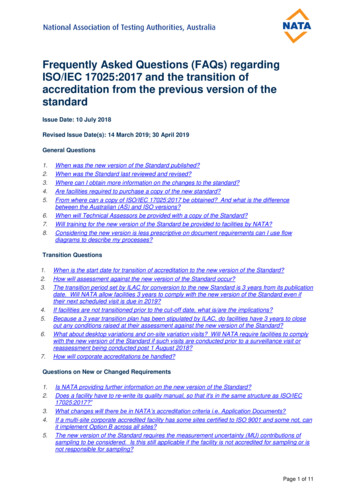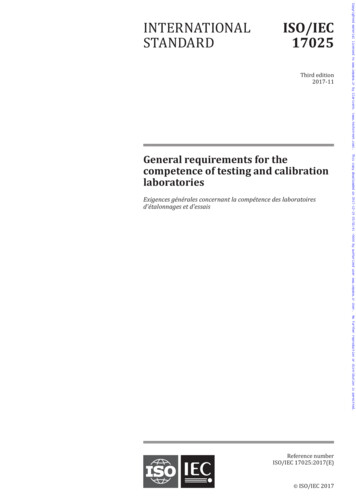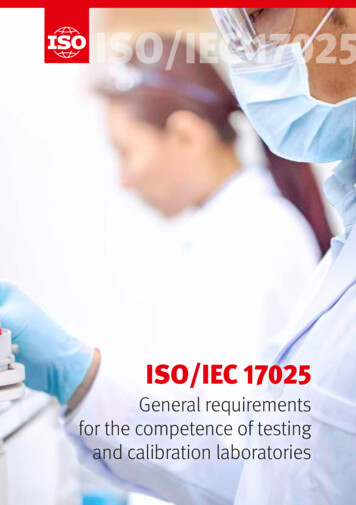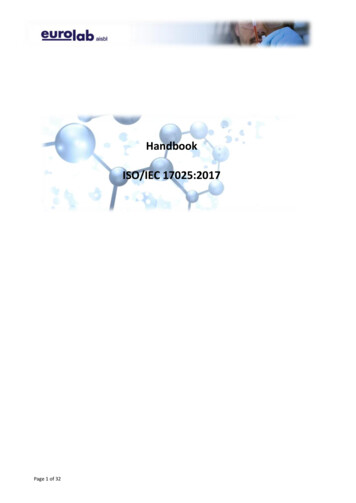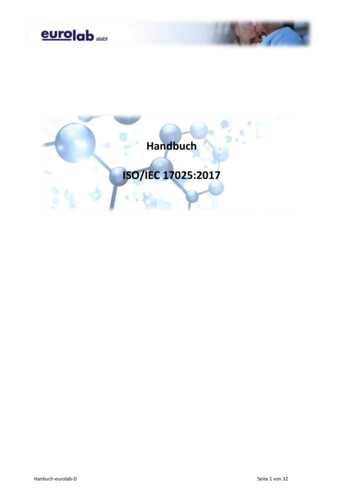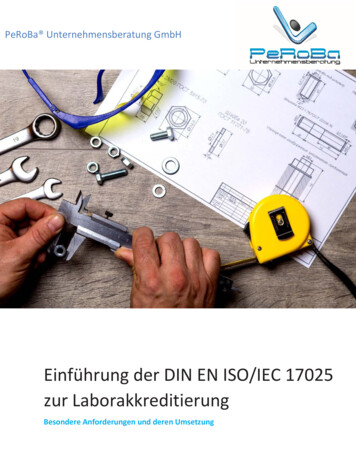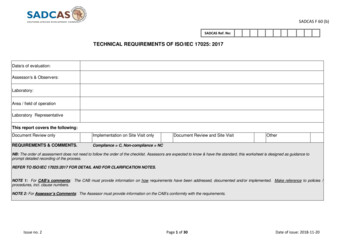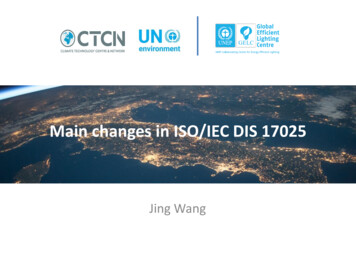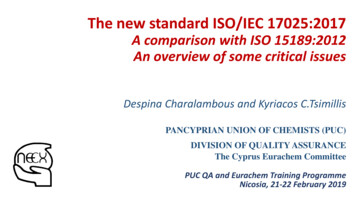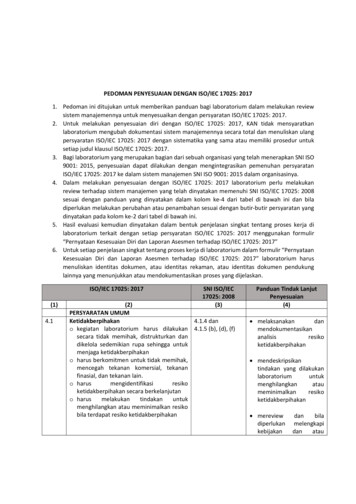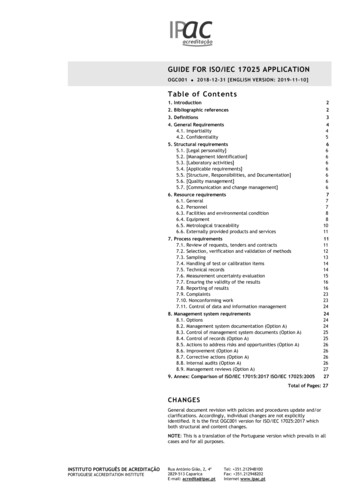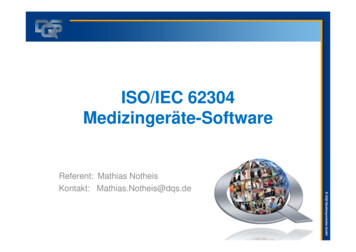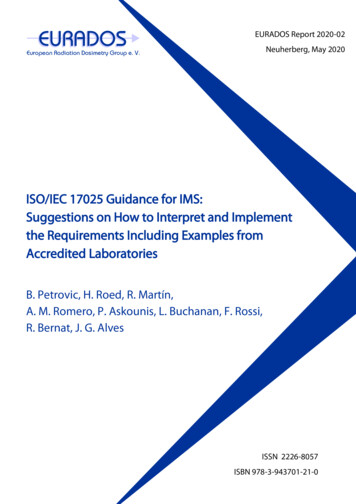
Transcription
EURADOS Report 2020-02Neuherberg, May 2020European Radiation Dosimetry Group e. V.ISO/IEC 17025 Guidance for IMS:Suggestions on How to Interpret and Implementthe Requirements Including Examples fromAccredited LaboratoriesB. Petrovic, H. Roed, R. Martín,A. M. Romero, P. Askounis, L. Buchanan, F. Rossi,R. Bernat, J. G. AlvesISSN 2226-8057ISBN 978-3-943701-21-0
European Radiation Dosimetry Group e. V.EURADOS Report 2020-02Neuherberg, May 2020ISO/IEC 17025 Guidance for IMS:Suggestions on How to Interpret and Implementthe Requirements Including Examples fromAccredited LaboratoriesAuthors: B. Petrovic1, H. Roed2, R. Martín3,A. M. Romero3, P. Askounis4, L. Buchanan5, F. Rossi6,R. Bernat7, J. G. Alves81PHI RS, B&H2DHA SIS, Denmark3CIEMAT, Spain4EEAE, Greece5AWE, UK6AOUC, Italy7RBI, Croatia8IST, PortugalISSN 2226-8057ISBN 978-3-943701-21-0
Imprint EURADOS 2020Issued by:European Radiation Dosimetry e. V.Ingolstädter Landstr. 185764 The European Radiation Dosimetry e.V. is a non-profit organisation promoting research anddevelopment and European cooperation in the field of the dosimetry of ionising radiation. It isregistered in the Register of Associations (Amtsgericht München, registry number VR 207982) andcertified to be of non-profit character (Finanzamt Braunschweig-Altewiekring, notification from2008-03-03).Liability DisclaimerNo liability will be undertaken for completeness, editorial or technical mistakes, omissions as well asfor correctness of the contents.
Content:Content: . iAbstract.iii1. Introduction .11.1 Structure of tables.12. Terms and definitions .23. Requirements from ISO/IEC 17025:2017 .33.1 Clause 4: General requirements .33.1.1 Sub-clause 4.1: Impartiality . 33.1.2 Sub-clause 4.2: Confidentiality . 63.2 Clause 5: Structural requirements .83.2.1 Sub-clauses 5.1 to 5.7 . 83.3 Clause 6: Resource requirements .133.3.1 Sub-clause: 6.2 Personnel. 133.3.2 Sub-clause 6.3: Facilities and environmental conditions. 173.3.3 Sub-clause 6.4: Equipment . 213.3.4 Sub-clause 6.5: Metrological traceability . 243.3.5 Sub-clause 6.6: Externally provided products and services . 263.4 Clause 7: Process requirements .303.4.1 Sub-clause 7.1: Review of requests, tenders and contracts . 303.4.2 Sub-clause 7.2: Selection, verification and validation of methods. 333.4.3 Sub-clause 7.3: Sampling . 363.4.4 Sub-clause 7.4: Handling of test or calibration items . 373.4.5 Sub-clause 7.5: Technical records . 403.4.6 Sub-clause 7.6: Evaluation of measurement uncertainty . 443.4.7 Sub-clause 7.7: Ensuring the validity of results . 473.4.8 Sub-clause 7.8: Reporting of results . 503.4.9 Sub-clause 7.9: Complaints . 543.4.10 Sub-clause 7.10: Nonconforming work . 563.4.11 Sub-clause 7.11: Control of data and information management. 583.5 Clause 8: Management system requirements .613.5.1 Sub-clause 8.1: Options . 613.5.2 Sub-clause 8.2: Management system documentation (Option A) . 633.5.3 Sub-clause 8.3: Control of management system documents (Option A) . 663.5.4 Sub-clause 8.4: Control of records (Option A) . 68-i-
3.5.5 Sub-clause 8.5: Actions to address risks and opportunities (Option A) . 703.5.6 Sub-clause 8.7: Corrective action (Option A) . 743.5.7 Sub-clause 8.8: Internal audits (Option A) . 763.5.8 Sub-clause 8.9: Management reviews (Option A). 78References .81Annex A: Organisation Chart Example .83Annex B: Position description form example .84Annex C: Example for “Evaluation of significance of deviations”.85Annex D: Authorisation Matrix Example .86Annex E: Supervision of Personnel Form Example .87Annex F: Comparison of environmental conditions of different standards .88Annex G: Report on Fulfilment of Requirements for Environmental ConditionsExample .89Annex H: A list of standards applicable to IMS capable of evaluating personal doses 90Annex I: Bad results as a consequence of improperly handled dosemeters .91Annex J: Report on IMS Participation in Personal Dosemeters IntercomparisonExample .92Annex K: Quality Report Example .95Annex L: Risk Register Example .97Annex M: Risk Register Notes Example and explanations .98Annex N: Corrective Action / Action for Improvement Report Example .100Annex O: Internal Audit Report Template (Example) .103- ii -
AbstractIndividual monitoring of external radiation is an activity usually regulated by national regulatorybodies in most countries. Regulations generally contain technical requirements to be met by theindividual monitoring services (IMS), in order to ensure that the measurements are correct andtherefore the dosimetry results are reliable. In some countries, the requirements include or evenconsist of the accreditation of the service according to the standard ISO/IEC 17025: “Generalrequirements for the competence of testing and calibration laboratories”. This document specifiesthe general requirements for the competence, impartiality and consistent operation of laboratories[1]. It is a fact that accreditation is a growing trend among European IMS as a way to guaranteeconfidence in their technical competence. The acceptance of the dosimetry results betweencountries and their indentation in the respective National Dose Registries is facilitated if laboratoriesconform to the ISO/IEC 17025 standard.In the framework of the activities of EURADOS (European Radiation Dosimetry Group) workinggroup 2 "Harmonisation of Individual Monitoring in Europe" and attending to the concern of manyEuropean IMS in the process of accreditation, this guide has been prepared by a dedicated taskgroup composed not only of experienced IMS staff, quality managers and accreditation auditors butalso by IMS personnel involved in the course of accreditation. The purpose of this task group was toassist and encourage IMS to apply for accreditation and to share their own accreditation experience.This document intends to be a practical reference for IMS on how to interpret and implement theISO/IEC 17025 requirements for testing laboratories to the specific activity of a personal dosimetryservice for external radiation, emphasising those aspects of special interest. As a new edition of theISO/IEC 17025 standard was released in 2017 [1], this guide also identifies the major differences ofISO/IEC 17025:2017 in comparison to the 2005 version [2]. The objective is to provide accredited IMSwith suggestions and examples on how to implement the novelties in their quality systems. It is alsoaimed to serve as a guide for accreditation auditors, who can find useful information and examplesthat could help them in decision making at audit. In the case of any doubt or discrepancy betweenwhat could be understood from the explanations of this publication and the text of the standard,the requirement of the standard should always prevail. At no time has it been the intention of theauthors to exclude other multiple ways of fulfilling the requirements that only the auditor can judge.The guide is structured following the ISO/IEC 17025:2017 contents and provides:Identification of changes or novelties regarding ISO/IEC 17025:2005.Suggestions on how to interpret the requirement applied to individual monitoring services.Suggestions on how to implement the requirement including practical recommendations.Examples of accredited dosimetry laboratories with different layouts.Assistance to prepare audits giving some examples of possible auditor’s questions and howto show evidence of compliance.Cross references with other ISO/IEC 17025:2017 clauses to take into account in order to beconsistent.- iii -
ISO 17025 guidance for IMS1. Introduction1.1 Structure of tablesEven though it is a general thought that accreditation is a proof of uniformity between IMS,experience has demonstrated that conforming to ISO/IEC 17025 does not indicate all the IMSoperate in the same way. Different requirements can be interpreted in several approaches and stillconform to the requirements of the standard. This of course depends on the IMS setup and theauditor’s custom-made assessment.This report provides advice to already accredited IMS taking into account novelties from the 2017edition, as well as to IMS that are about to apply for the accreditation process. The structure of thereport is conceived in the table form (Table 1) providing clear overview of the specific interest to theuser. Tables are complemented with a series of annexes making available examples from alreadyaccepted national accreditation bodies of the authors’ respective countries. The purpose of thereport was to “harmonise” the accreditation process and contribute to the uniformity among IMS.Table 1New in ISO/IEC 17025:2017?Suggestions on how to interpret the requirementSuggestions on how to implement the requirementExamples from accredited laboratoriesAudits Possible auditor’s questions Showing evidence of complianceCross reference with other ISO/IEC 17025:2017 sub-clausesEURADOS Report 2020-02-1-
B. Petrovic et al.2. Terms and definitionsAs most of the terms related to quality and management systems are given in relevant ISO (e.g. ISO9000:2015; ISO/IEC 17025:2005, JCGM 200:2012, etc.) and technical terms related to externaldosimetry are given in international documents or standards (e.g. RP 160 and BSS), these generalterms are not included in this section. The purpose of this glossary was to avoid confusion betweensimilar terms used in the report.Accreditation – third-party attestation related to a conformity assessment body conveying formaldemonstration of its competence, consistent operation and impartiality to carry out specificconformity assessment tasks [3].Competence – demonstrated ability to apply knowledge and skills.Conformity assessment body in this document is the body competent to carry out conformityassessment tasks for the laboratory p
ISO/IEC 17025:2017 in comparison to the 2005 version [2]. The objective is to provide accredited IMS with suggestions and examples on how to implement the novelties in their quality systems. It is also aimed to serve as a guide for accreditation auditors, who can find useful information and examples that could help them in decision making at audit. In the case of any doubt or discrepancy .
